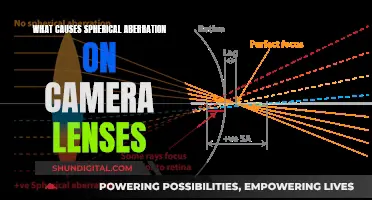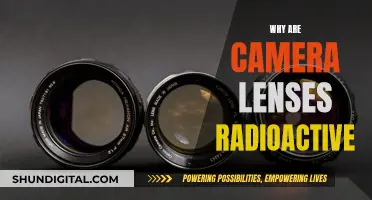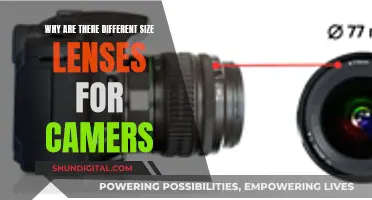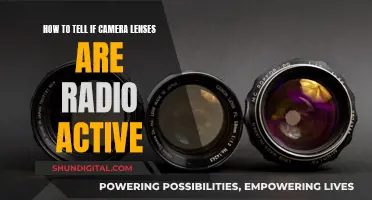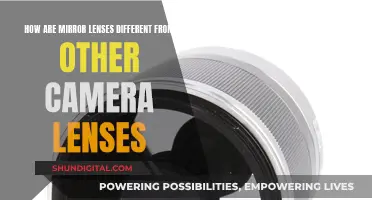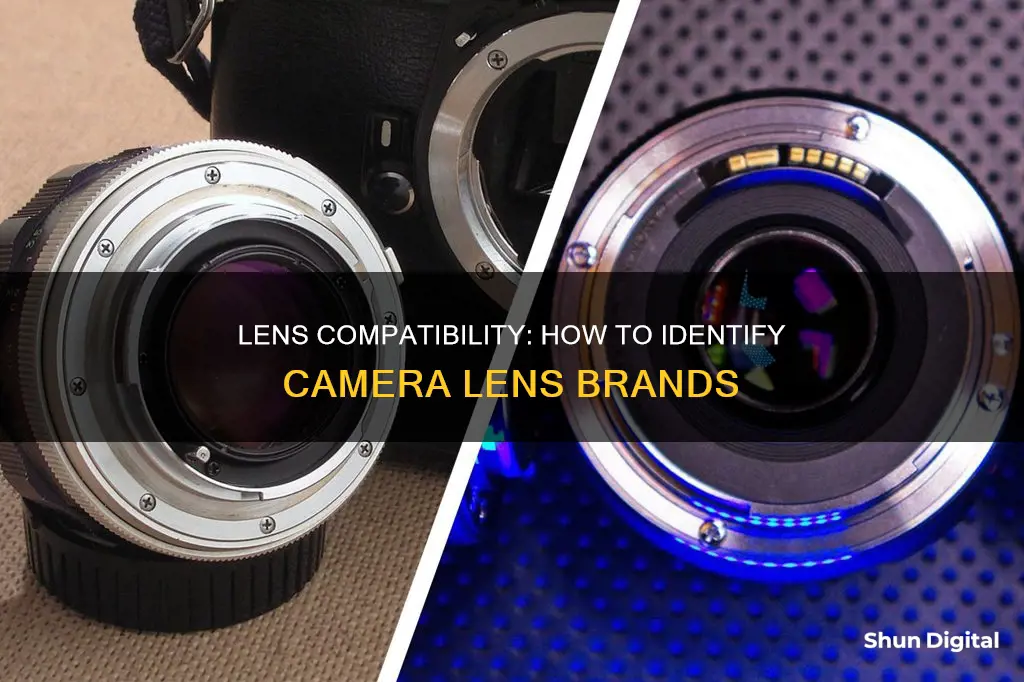
Choosing a camera lens can be a daunting task, especially when you're not sure if it will fit your camera. The compatibility of a lens with your camera depends on several factors, including the camera brand, mount type, lens focal length, and zoom range. Different camera brands, such as Canon, Nikon, and Sony, have their own unique lens mounts, so ensuring that the lens you choose is designed for your specific camera brand is crucial. Additionally, some camera models within the same brand may have different mount types, such as Canon's EF mount for full-frame cameras and EF-S mount for APS-C sensor cameras. It's important to consult your camera's manual or the manufacturer's website to determine compatible lens options.
| Characteristics | Values |
|---|---|
| Camera brand | Canon, Nikon, Sony, Fujifilm, Pentax, etc. |
| Camera model | Canon DSLR, Canon mirrorless, Nikon DSLR, etc. |
| Camera mount | EF, EF-S, M, R, F, Z, E, FE, etc. |
| Sensor size | APS-C, full-frame, medium format, etc. |
| Lens mount | EF, EF-S, M, R, F, Z, E, FE, etc. |
| Lens type | DSLR, mirrorless, APS-C, full-frame, etc. |
| Third-party lenses | Sigma, Tamron, Tokina, Rokinon, Laowa, Zeiss, etc. |
What You'll Learn

Understand lens mounts
Understanding lens mounts is key to knowing whether a lens will fit your camera. The lens mount is the junction where the camera and the lens meet and click into place. Each camera brand has its own unique lens mount, and sometimes specific camera lines within a brand will have distinct mounts. This means that a lens from one brand will often not fit a camera from another without an adapter. Canon, for instance, uses the EF mount, while Nikon uses the F mount, and Sony uses the E mount.
Lens mounts are usually designated by a series of letters, such as EF, EF-S, M, and R. The mount type affects lens compatibility with your camera. So, when choosing a new lens, the first thing to check is whether its mount matches your camera device. For example, if you have a Canon camera, you will generally need a lens with a Canon EF mount.
Lens adapters can be used to connect lenses and cameras with different types of mounts. Adapters are often brand-specific, and while they can increase your options, they may also limit lens functionality. For instance, your lens might not focus as quickly, or you might have to adjust settings manually.
Japan's Camera Lens Market: Affordable Photography Superpower?
You may want to see also

Know your camera model
Knowing your camera model is essential to ensuring that you purchase a compatible lens. Camera bodies and lenses are designed with specific mounts, which determine whether a lens can physically fit and communicate with the camera body. These mounts are often unique to each brand and sometimes to specific camera lines within a brand. Therefore, it is crucial to identify your camera's exact model, which is typically found on the camera body.
Once you know your camera model, you can refer to the user manual, which often lists compatible lenses. Alternatively, you can visit the manufacturer's website and search for your camera model to find information on lens compatibility. Online resources, such as forums and websites, also provide valuable insights and compatibility charts. It is worth noting that some third-party lens manufacturers, like Sigma and Tamron, produce lenses with different mounts to cater to various camera brands.
Another important consideration is the type of photography you plan to do. Different lenses offer different focal lengths and features, such as zoom or prime lenses. If you are interested in landscape photography, for example, you would want a wide-angle lens with a focal length of around 10-24mm. On the other hand, portrait photography typically calls for a lens with a focal length of 50-85mm to achieve a flattering perspective.
Lastly, it is worth mentioning that some camera brands have different mount types depending on the camera model. For instance, Canon has the EF mount for full-frame cameras and the EF-S mount for APS-C sensor cameras. Nikon also has the F mount for full-frame cameras and the DX mount for APS-C sensor cameras. Understanding these nuances will help ensure that you purchase a lens that is specifically designed for your camera model and mount type.
Cleaning Your Galaxy S6 Camera Lens: A Step-by-Step Guide
You may want to see also

Consult the user manual or manufacturer's website
Consulting the user manual or the manufacturer's website is a reliable way to determine lens compatibility with your camera. This step is crucial, as using an incompatible lens can lead to issues such as the lens not fitting properly, communication errors, or even damage to the camera body.
User manuals often provide a list of compatible lenses for your specific camera model. By referring to this information, you can ensure that the lens you choose will physically fit and function correctly with your camera. This is especially important when dealing with different camera brands, as they usually have their own proprietary lens mounts. For example, Canon cameras typically use the EF or RF mount, while Nikon cameras use the F or Z mount.
Additionally, the user manual or manufacturer's website may provide details about the lens mount type and sensor size, which are essential factors in determining lens compatibility. The lens mount refers to the junction where the camera and lens meet, and it varies across different camera brands and models. Common lens mounts include EF, EF-S, M, and R, which are usually denoted by letters. Knowing the lens mount of your camera will help you choose a lens with a matching mount to ensure compatibility.
Furthermore, understanding the sensor size of your camera is crucial for lens compatibility. Most interchangeable-lens cameras have either a full-frame or APS-C sensor. Full-frame lenses can be used on cameras with smaller sensors, but the image will appear zoomed-in or cropped. On the other hand, using a lens designed for a smaller sensor on a full-frame camera can result in vignetting or a reduction in image quality.
By consulting the user manual or the manufacturer's website, you can gain valuable insights into the specific lenses that are compatible with your camera model. This information will guide you in choosing lenses that fit properly and function as intended, ensuring optimal performance and creativity in your photography endeavours.
Bridge Cameras: Interchangeable Lenses and Their Limitations
You may want to see also

Check online resources
There are many online resources and forums dedicated to photography that provide detailed information about different lens mounts and their compatibility with camera models. These resources can be a great way to determine whether a specific lens will fit your camera. Here are some tips on how to use these online resources effectively:
- Start by researching your camera model and manufacturer. Most camera manufacturers have specific lens mounts unique to their brand. Look for information on the manufacturer's website, camera manuals, or online forums dedicated to that camera brand. Canon cameras, for instance, have four mount types, which can be identified by looking at the lens mount index.
- Consult online compatibility charts: Many websites and forums provide compatibility charts that list camera models and their compatible lenses. These charts can help you quickly determine if a particular lens will fit your camera.
- Engage with photography communities and forums: Online communities and forums are a great way to connect with experienced photographers who can provide guidance based on their own experiences. They can offer advice on lens compatibility and may also have insights on adapting vintage or third-party lenses to your camera.
- Use online retailers: Websites like B&H Photo Video allow you to search for lenses compatible with your camera model. You can filter your search by lens adapter, mount type, or camera brand to find lenses that will fit your camera.
- Refer to online guides and articles: Online guides and articles, such as those found on dpreview.com, can offer comprehensive information on lens compatibility, including fit, format coverage, and lens mounts. These guides can help you understand the technical aspects of lens compatibility and make more informed decisions.
- Stay up to date: Keep in mind that new lens mounts are introduced regularly as camera technology evolves. Therefore, it is important to stay updated with the latest information from manufacturers and online communities to ensure accurate identification and compatibility.
By utilising these online resources, you can make informed decisions about lens compatibility and ensure that you purchase the right lenses for your camera.
Easy Guide to Editing Photos with Round Camera Lenses
You may want to see also

Consider lens adapters
Lens adapters are devices that allow you to attach a camera lens to a camera body with a different mount. They serve as an intermediary between different brands or types of camera systems, expanding your lens options. For example, a mount adapter can allow you to use a Canon EF lens on a Sony E-mount camera, or a Canon EF lens on a Canon EOS R mirrorless camera. Nikon and Sony also offer lens converters that enable autofocus and auto-exposure functionality between the lens and camera.
Lens adapters provide photographers with versatility, allowing them to mix and match cameras and lenses from different brands. They offer cost-effectiveness, creative freedom, and the ability to preserve investments in high-quality lenses when switching camera brands. However, using lens adapters may come with compromises such as slower autofocus performance, loss of automatic features, and potential image quality degradation.
When choosing a lens adapter, it is important to consider compatibility with both the camera and the lens. Ensure that the adapter supports the mount types of both the camera and the lens, and check if it retains autofocus and other electronic connections. Build quality and optical elements, such as additional glass elements or coatings, can also impact the performance of the adapter.
While lens adapters can be a great investment for photographers, it is crucial to research and select high-quality adapters to maintain image sharpness and avoid introducing optical imperfections or mechanical issues.
Benefits of Lens Adapters:
- Expand your lens options: Access a wider range of lenses, including specialty lenses such as vintage, unique focal length, or specific brand lenses.
- Cost-effectiveness: Save costs by continuing to use existing lenses when upgrading or switching camera bodies.
- Creative freedom: Experiment with different lenses to find the perfect combination for your artistic vision.
- Specialized uses: Use specific lenses for particular types of photography, such as macro, astrophotography, or architectural work.
- Preserve investments: Adapt high-quality lenses from one brand to another without starting from scratch.
Compromises of Using Lens Adapters:
- Autofocus performance: Autofocus may be slower or less reliable compared to using a native lens directly on the camera body.
- Loss of automatic features: Some adapters may not support electronic communication between the lens and camera, resulting in the loss of features like aperture control, image stabilisation, or EXIF data recording.
- Image quality: Poorly made adapters can introduce optical imperfections, mechanical issues, or slight degradation in image quality due to the added distance between the lens and sensor.
Universal Camera Lenses: A Myth or Reality?
You may want to see also
Frequently asked questions
The junction where your camera meets the lens is called the mount. Each camera brand has its own unique mount, so you need to ensure that the lens you choose is compatible with your camera's mount. Canon, for example, uses the EF mount, while Nikon has the F mount, and Sony uses the E mount.
You can use adapters to connect lenses and cameras from different brands. However, adapters may limit lens functions, such as autofocus or aperture control, and the fit may not be as secure.
If the lens mount of the camera and lens do not match, you will need an adapter. You can also refer to the spec sheet for the lens and body, or consult the user manual or manufacturer's website to check for compatible lenses.
Yes, within each brand, there may be different mount types depending on the camera model. For instance, Canon has the EF mount for full-frame cameras and the EF-S mount for APS-C sensor cameras.
Mirrorless cameras often have their own lens mounts, so it's important to check the lens options available for your specific camera model. You can adapt DSLR lenses to a mirrorless camera, but not the other way around.


